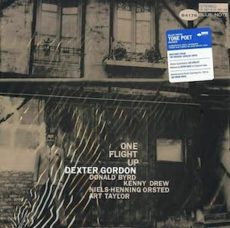
Requisites
It happened like this; I was choosing several albums to listen to for my next column when a delightful surprise showed up at my door. After auditioning it, I wanted to share my thoughts with you. I first heard this morning’s subject of discussion by Dexter Gordon, One Flight Up (Blue Note BLP 4176/BST 84176) in 1967 during one of my Saturday visits to Record Rendezvous in Cleveland, Ohio. This was his sixth Blue Note album and his second release since moving overseas from the United States. Dexter was a staple on the jazz scene since the forties when he was a member of Billy Eckstine’s Big Band. He was a major influence for two other tenor giants, John Coltrane, and Sonny Rollins. He moved abroad because he was treated more fairly and as an equal than in the US. There was also plenty of work for him and other musicians in some of the best jazz clubs Europe and France had to offer.
In this album, the tenor saxophonist leads a first-class ensemble of Donald Byrd on trumpet, Kenny Drew on piano, Neils-Henning Orsted Pedersen on bass, and Art Taylor on drums. My copy used in this report is the 2021 Blue Note Tone Poet Series Stereo Audiophile reissue sharing the original catalog number. Side One is occupied by Donald Byrd’s Tanya allowing the tenor, trumpet, and piano three lengthy solo opportunities. The rhythm section opens with a brief introduction segueing into a dreamy collective theme. Dexter works his magic first on nearly six minutes of immaculate execution. Donald follows, appealing at every turn on the next reading. Kenny speaks proudly with a firm articulation on the finale that keeps us captivated by Neils-Henning’s and Art’s stylish foundation ahead of the quintet’s closing chorus and gentle dissolve.
Side Two starts with Kenny Drew’s, Coppin’ The Haven. The trio eases into the song with a brief introduction leading to Byrd and Gordon stating the melody to the rhythm section’s infectious beat. Dexter crafts the opening solo with a touch of the blues that sustains its momentum until the conclusion. Donald comes in next with an exquisite reading as smooth as glass. Kenny serves up an impressive final statement preceding the climax. The album ends with the beautiful 1939 standard, Darn That Dream by Jimmy Van Heusen and Eddie DeLange. This is a gorgeous quartet performance opening with a gentle trio introduction. Dexter is the centerpiece here and he produces a beautifully seductive melody and tender first reading. Kenny expresses a gentle warmth on the second interpretation, then Gordon returns to close with a sensuously smooth ending.
One Flight Up was recorded by the French engineer, Jacques Lubin. This Tone Poet reissue was supervised by Joe Harley, and the mastering is by Kevin Gray at Cohearent Audio. The sound quality is spectacular with refreshing clarity and a stunning soundstage that transports the musicians to your listening room. The record was pressed on 180-gram audiophile vinyl and is silent until the music starts. Then, the gatefold photos inside could adorn any wall proudly. Over his nearly forty-year career, Dexter recorded for a host of labels, Bethlehem, Columbia, Decca, Dial, Dootone, Prestige, Savoy, and SteepleChase. However, it was the five years he was at Blue Note (1961-1966) that are among his finest records in my opinion. He passed away on April 25, 1990, at age sixty-seven from kidney failure and cancer of the larynx. If you’re a Hard-Bop fan, I highly recommend One Flight Up by Dexter Gordon. It’s an excellent album where the music speaks to you in a way that’s rewarding listening for any jazz library!
~ Darn That Dream – Source: JazzStandards.com ~ Dexter Gordon – Source: Wikipedia.org © 2021 by Edward Thomas Carter
More Posts: choice,classic,collectible,collector,history,instrumental,jazz,music,saxophone


